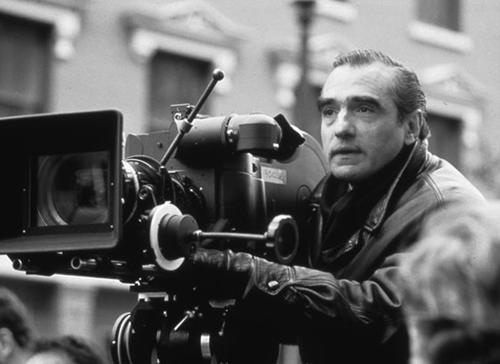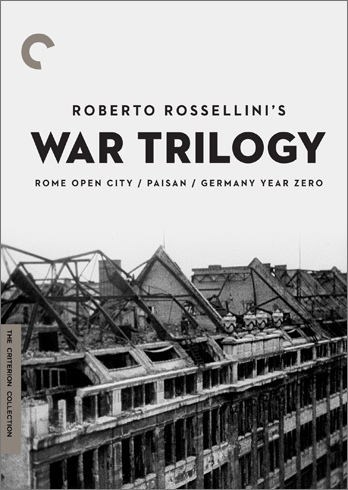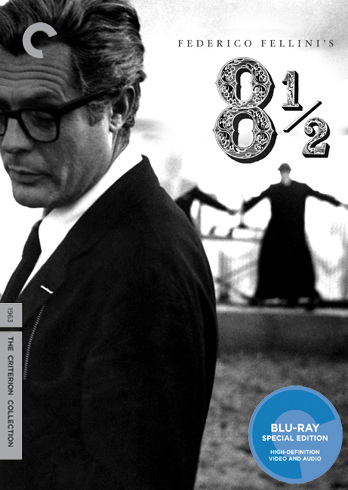
馬丁史柯西斯 Martin Scorsese’s Top 10
Martin Scorsese is an Academy Award–winning filmmaker who has directed more than twenty features, including The Last Temptation of Christ, available from the Criterion Collection. He is the founder of the nonprofit Film Foundation and World Cinema Project, dedicated to preserving and presenting marginalized films from around the globe. A box set of World Cinema Project titles is available from Criterion.
1. 游擊隊 Paisan | 羅貝托羅塞里尼 Roberto Rossellini

在我到意大利旅行中,我們製作的關於意大利電影的紀錄片,我們從這張照片開始。 對我來說,這真的是一個開始。 我和祖父母在電視上第一次看到,他們在本世紀之交離開家園以來,對自己家鄉發生的壓倒性反應就像現在和生動的,像我一樣的形象和人物。 我正在體驗電影本身的力量,在這種情況下遠遠超出了好萊塢,在惡劣的條件下和劣質的設備。 而且我也看到電影不僅僅是電影本身,而是電影與觀眾之間的關係。 費里尼說,當羅塞里尼拍攝寶谷序列時,他採取純粹的本能,隨著自由發明。 結果在這一集,西西里和那不勒斯和佛羅倫薩劇集中,仍然令人吃驚:就像看到現實本身在你眼前展現的一樣。
In My Voyage to Italy, the documentary that we made about Italian cinema, we started with this picture. For me, it really was the beginning. I saw it for the first time on television with my grandparents, and their overwhelming reaction to what had happened to their homeland since they left at the turn of the century was just as present and vivid for me as the images and the characters. I was experiencing the power of cinema itself, in this case made far beyond Hollywood, under extremely tough conditions and with inferior equipment. And I was also seeing that cinema wasn’t just about the movie itself but the relationship between the movie and its audience. Fellini said that when Rossellini was filming the Po Valley sequence, he acted on pure instinct, inventing freely as he went along. The result—in that episode, and in the Sicilian and Neapolitan and Florentine episodes as well—is still startling: it’s like seeing reality itself unfolding before your eyes.
2. 《紅菱艷》The Red Shoes | 1948 | 英國 | 麥克鮑威爾, 艾默瑞克普萊斯柏格

多年來,我已經對這張圖片說了很多, 對我來說,它一直是迄今為止最偉大的事情之一,每次我回頭看一次,每年大約一次 - 這是新的:它揭示了另一面,另一個層次,並且更深入。 紅鞋是什麼特別的? 當然,它是美麗的,是最美麗的Technicolor電影之一; 莫伊拉·希勒(Moira Shearer)正在走向安東·瓦爾布魯克(Anton Walbrook)的別墅,特別是在新建的修復中,現在還有一種非凡的魔法感 - 看起來她漂浮在閃閃發亮的光線和空氣中。 而且沒有其他的圖片戲劇化和可視化的壓倒性的藝術痴迷,它可以佔用你的生活的方式。 但在更深層次上,在電影本身的運動和精力方面,對藝術的深刻和持久的愛,對藝術的信仰是一個真正超越的國家。
I’ve said and written so much about this picture over the years; for me it’s always been one of the very greatest ever made, and every time I go back to look at it—about once a year—it’s new: it reveals another side, another level, and it goes deeper. What is it that’s so special about The Red Shoes? Of course, it’s beautiful, one of the most beautiful Technicolor films ever made; it has such an extraordinary sense of magic—look again at the scene where Moira Shearer is walking up the steps to Anton Walbrook’s villa, especially in the new restoration: it seems like she’s floating on currents of sparkling light and air. And there’s no other picture that dramatizes and visualizes the overwhelming obsession of art, the way it can take over your life. But on a deeper level, in the movement and energy of the filmmaking itself, is a deep and abiding love of art, a belief in art as a genuinely transcendent state.
3. 河 The River | 尚雷諾

戰爭結束後的幾年是電影中非常特別的時刻,世界各地。數百人被屠殺,整個城市平整,人類的信仰本身就被動搖。最偉大的電影人被移動創造了存在的冥想,在生命本身的奇蹟。他們沒有遠離惡劣和暴力 - 恰恰相反。相反,他們直接處理他們,然後遠離越來越遠的距離。我正在考慮Rossellini的“聖弗朗西斯之花”和“歐羅巴的花”51,Visconti和De Sica,Mizoguchi的Ugetsu和Sansho,執達官,黑澤的Ikiru和七武士,Wyler的“我們的生命的最好的歲月”,福特的我的偉大的新近的電影親愛的克萊門汀和貨車大師,這個非凡的畫面。這是Jean Renoir在他的美國時期之後的第一張照片,他的第一個顏色,他用Rumer Godden的自傳小說,創造一部真正關於生活的電影,一部沒有真正故事的電影,就是存在的節奏,出生死亡和再生的循環,以及世界的瞬息萬變。
The years right after the war were a very special time in cinema, all around the world. Millions were slaughtered, entire cities were leveled, humanity’s faith in itself was shaken. The greatest filmmakers were moved to create meditations on existence, on the miracle of life itself. They didn’t look away from harshness and violence—quite the contrary. Rather, they dealt with them directly and then looked beyond, from a greater and more benign distance. I’m thinking of Rossellini’s The Flowers of St. Francis and Europa ’51, the great neorealist films by Visconti and De Sica, Mizoguchi’s Ugetsu and Sansho the Bailiff, Kurosawa’s Ikiru and Seven Samurai, Wyler’s The Best Years of Our Lives, Ford’s My Darling Clementine and Wagon Master, and this remarkable picture. This was Jean Renoir’s first picture after his American period, his first in color, and he used Rumer Godden’s autobiographical novel to create a film that is, really, about life, a film without a real story that is all about the rhythm of existence, the cycles of birth and death and regeneration, and the transitory beauty of the world.
4. 雨月物語 Ugetsu | 溝口健二

溝口是誰曾在電影中合作的最偉大的大師之一; 他是正確那裡與雷諾阿和茂瑙和福特,並在戰爭結束後他做了三幅圖片,生命Oharu,雨月,和山椒大夫,是站在電影的頂峰。 他所有的藝術性都被引入了最為非凡的簡約。 你是面對面的一些神秘的,不可避免的,然後,最後,和平解除。 我喜歡這三張照片,還有許多其他的Mizoguchi電影 (including Princess Yang Kwei-fei, The Story of the Last Chrysanthemums, and Miss Oyu, to name only a few)但是,Ugetsu對我來說效果最強。 圖片中有片刻,著名的,我一次又一次地看到,總是把我的呼吸:船慢慢地從霧中實現,並向我們前進...Genjuro在狂喜的草地上坍塌,被Wakasa夫人窒息... 最後的起重機從兒子在母親的墳墓上向曠野外提供祭品。 只是想想這些時刻,現在讓我驚嘆不已。
Mizoguchi is one of the greatest masters who ever worked in the medium of film; he’s right up there with Renoir and Murnau and Ford, and after the war he made three pictures—The Life of Oharu, Ugetsu, and Sansho the Bailiff—that stand at the summit of cinema. All of his artistry is channeled into the most extraordinary simplicity. You’re face-to-face with something mysterious, tragically inevitable, and then, in the end, peacefully removed. I love all three of these pictures and many other Mizoguchi films as well (including Princess Yang Kwei-fei, The Story of the Last Chrysanthemums, and Miss Oyu, to name only a few), but Ugetsu has the most powerful effect on me. There are moments in the picture, famous ones, that I’ve seen again and again and that always take my breath away: the boat slowly materializing from out of the mist and coming toward us . . . Genjuro collapsing on the grass in ecstasy and being smothered by Lady Wakasa . . . the final crane up from the son making an offering at his mother’s grave to the fields beyond. Just to think of these moments now fills me with awe and wonder.
5. 灰燼與鑽石 Ashes and Diamonds | 安德烈‧華依達

我在1961年第一次看到灰燼和鑽石。甚至在那個時候,當我們期待在電影中驚訝的時候,當世界各地的事情發生時,它震驚了我。它與現在和困擾的外觀有關,就像一場不會停止展開的噩夢;瘋狂瘋狂和荒謬的感覺,戰時邊界的和平邊緣的政治鬥爭的悲劇;和主演,Zbigniew Cybulski的美麗。這部電影有幻覺的力量:我可以閉上眼睛,某些圖像將會在五十年前第一次看到他們的時候,用自己的力量閃回我身邊。多年來,我和Andrzej Wajda交叉了幾次,我一直對他的精力和永恆的願景感到敬畏。幾年前我再次見到他,一個有點虛弱的人,但仍然像在90年代一樣燃燒的能量,他正在準備再製作一部關於萊赫·瓦文薩的電影(最後一期)的三部曲,從大理石和鐵人的人開始)。他是所有電影人的榜樣。
I saw Ashes and Diamonds for the first time in 1961. And even back then, during that period when we expected to be astonished at the movies, when things were happening all over the world, it shocked me. It had to do with the look, both immediate and haunted, like a nightmare that won’t stop unfolding; the sense of maddening insanity and absurdity, the tragedy of political infighting on the brink of peace and coming of age during wartime; and the beauty of the lead actor, Zbigniew Cybulski. The film has the power of a hallucination: I can close my eyes and certain images will flash back to me with the force they had when I saw them for the first time over fifty years ago. I’ve crossed paths with Andrzej Wajda a few times over the years, and I’ve always been in awe of his energy and his unflinching vision. I saw him again a couple of years ago, a little frailer but still as burning with energy as he’d been back in the ’90s, and he was preparing to make another film, now just completed, about Lech Walesa (the final installment of the trilogy that began with Man of Marble and Man of Iron). He’s a model to all filmmakers.
6. 情事 L’avventura | 安東尼奧尼

這是另一部電影,這麼多年來,你已經說過和寫了,你想起來:沒有什麼可說的。 。 。但是當然,這是永遠是一個失敗的原因,因為它永遠不會是真的 - 對於一部電影來說,總是有更多的看法,再次看到它是重新看到,在2014年看到而不是1960年是一個非常不同的經歷,對於一些人來說,它將會真正是全新的(對於那些人,我會說,簡單地說:看吧!現在!)很難想像一部電影對人們對他們周圍的世界的束縛,對他們的看法,觸感和品味和聽覺有著更強大的認識。我知道L'avventura應該是與他們周圍的“疏遠”的人物,但是這個詞經常被用來描述這部電影和Antonioni的電影,它或多或少地關閉了思想。事實上,我比以往任何時候都看到,作為一部關於精神痛苦的人的電影:他們的精神信號被打亂了,這就是為什麼他們看到周圍的世界是敵對和不原諒的。在視覺上,主觀上,主題,戲劇性地,以各種方式,它是電影的偉大作品之一。
Here’s another film of which so much has been said and written over the years that you wind up thinking: There’s nothing left to say . . . But of course, that’s always a cop-out because it’s never true—there’s always more to say about a film, to see it again is to see it anew, to see it in 2014 as opposed to 1960 is a very different experience, and for some people it will literally be brand-new (to those people, I would say, simply: See it! Now!!). It’s difficult to think of a film that has a more powerful understanding of the way that people are bound to the world around them, by what they see and touch and taste and hear. I realize that L’avventura is supposed to be about characters who are “alienated” from their surroundings, but that word has been used so often to describe this film and Antonioni’s films in general that it more or less shuts down thought. In fact, I see it, more than ever, as a movie about people in spiritual distress: their spiritual signals are disrupted, which is why they see the world around them as hostile and unforgiving. Visually, sensually, thematically, dramatically, in every way, it’s one of the great works of cinema.
7. 龍頭之死 Salvatore Giuliano | 法蘭西斯科‧羅西

弗朗切斯科·羅西(Francesco Rosi)的偉大的歷史和政治馬賽克是對西西里匪徒Salvatore Giuliano暗殺情況的戲劇性調查。在一個層面上,這是一部非常複雜的電影:沒有中心主角(朱利亞諾本人不是一個人物,而是一個動作所圍繞的人物),它在時間框架和觀點之間轉變。但這也是從裡面形成的圖片,對西西里島及其人民的深刻和持久的愛和理解以及他們不得不忍受的背叛和腐敗。這是一個嚴格的調查(Rosi實際上發現了關於這個案件的新事實),但它從來沒有乾,它的血液流經其靜脈,它被黑色和白色射擊,絕對是電氣化的(電影攝影師是Gianni Di Venanzo,他拍攝了許多最引人注目的是五十年代和六十年代的意大利圖片,其中包括Antonioni的L'eclisse和Fellini的8½)。而薩爾瓦多·朱利亞諾(Salvatore Giuliano),其中還有許多其他的東西,就是西西里島,我的家人的土地,讚美讚美,因此,我珍惜它。
Francesco Rosi’s great historical and political mosaic is a dramatic inquiry into the circumstances around the assassination of the Sicilian bandit Salvatore Giuliano. On one level, it’s an extremely complex film: there’s no central protagonist (Giuliano himself is not a character but a figure around which the action pivots), and it shifts between time frames and points of view. But it’s also a picture made from the inside, from a profound and lasting love and understanding of Sicily and its people and the treachery and corruption they’ve had to endure. It’s a rigorous investigation (Rosi actually uncovered new facts about the case), but it’s never dry, it has blood flowing through its veins, and it’s shot in black and white that is absolutely electrifying (the cinematographer was Gianni Di Venanzo, who shot many of the greatest Italian pictures of the ’50s and ’60s, including Antonioni’s L‘eclisse and Fellini’s 8½). And Salvatore Giuliano is, among many other things, a grand hymn to Sicily, the land of my family, and for that reason alone I cherish it.
8.《八又二分之一 》| 1963 | 義大利/法國 | 費德里柯·費里尼

Fellini在La dolce vita之後做什麼?我們都想知道他怎麼會自己頂他甚至想要自己頂他會換檔嗎?最後,他做了一件沒有人可以預料到的事情。他拍攝了自己的藝術和生活情況 - 一個電影製片人,他的名字有八個半部電影(兩集合電影的集合和Alberto Lattuada在品種燈上共享的信用計算為他一半的電影,加上七),以他的最後一個功能取得國際知名度,當時間到了後面,感到巨大的壓力 - 他圍繞它製作了一部電影。 8½一直是我的試金石,在許多方面 - 自由,發明感,潛在的嚴謹和渴望的深層核心,迷人,相機運動和組合的物理拉動(另一個偉大的黑色和 - 白色的電影:每個圖像閃耀如珍珠 - 再次,由Gianni Di Venanzo拍攝)。但它也提供了一個不可思議的肖像作為當下的藝術家,試圖調出所有的壓力和批評,奉獻和要求和建議,找到空間和平靜只是聽自己。這張照片多年來激發了許多電影(包括亞歷克斯在仙境,星塵記憶和全爵士樂),我們已經看到吉多的困境,馬塞羅·馬斯蒂尼尼(Marcello Mastroianni)扮演的英雄在現實中重複了許多次 - 看看鮑勃·迪倫在“無方向之家”期間的生活,僅舉一個例子。像紅鞋一樣,我每年都會再看一遍,而且總是有不同的經歷。
What would Fellini do after La dolce vita? We all wondered. How would he top himself? Would he even want to top himself? Would he shift gears? Finally, he did something that no one could have anticipated at the time. He took his own artistic and life situation—that of a filmmaker who had eight and a half films to his name (episodes for two omnibus films and a shared credit with Alberto Lattuada on Variety Lights counted for him as one and a half films, plus seven), achieved international renown with his last feature and felt enormous pressure when the time came for a follow-up—and he built a movie around it. 8½ has always been a touchstone for me, in so many ways—the freedom, the sense of invention, the underlying rigor and the deep core of longing, the bewitching, physical pull of the camera movements and the compositions (another great black-and-white film: every image gleams like a pearl—again, shot by Gianni Di Venanzo). But it also offers an uncanny portrait of being the artist of the moment, trying to tune out all the pressure and the criticism and the adulation and the requests and the advice, and find the space and the calm to simply listen to oneself. The picture has inspired many movies over the years (including Alex in Wonderland, Stardust Memories, and All That Jazz), and we’ve seen the dilemma of Guido, the hero played by Marcello Mastroianni, repeated many times over in reality—look at the life of Bob Dylan during the period we covered in No Direction Home, to take just one example. Like with The Red Shoes, I look at it again every year or so, and it’s always a different experience.

9. 輕蔑 Contempt | 尚盧高達

我曾經認為戈達爾和安東尼奧尼是電影院偉大的色彩師的偉大的現代視覺藝術家,誰組成框架畫家組成他們的畫布。我還是這麼認為,但我也在情緒層面上與他們聯繫。對我來說,蔑視是其時代最動魄的電影之一。當時,人們談論了不可思議的藝術家的組合:一個多語言的卡羅·蓬蒂生產的Alberto Moravia小說,由Brigitte Bardot主演,由Michel Piccoli和Jack Palance主演,設在Cinecittà和Casa Capal的Casa Malaparte,指導由Jean-Luc Godard先生,Fritz Lang為自己。電影本身在細節上的固定中有點迷失。當電影發行時看起來如此相關和重要的情況,隨著歲月的流逝,這是有趣的。當時我並不關心所有這些背景信息,我只是回答了我在屏幕上看到的內容,但是在過去的幾年裡,蔑視已經越來越多地變得越來越難以承受。這是一場破裂的婚姻肖像,它的裁剪非常深刻,特別是在Piccoli和Bardot之間漫長而合理的著名場景中,即使你不知道戈達爾自己與Anna Karina的婚姻是分開的時間,你可以感受到它的動作,場景的運動,互相展開如此痛苦,但是莊重地,像一片悲劇性的音樂。蔑視也是對當時正在消失的一種電影院的哀悼,弗里茨·朗(Fritz Lang)所體現的,以及他所指揮的“奧德賽”的不可改編。而這是與永恆的深刻的電影相遇,失去的婚姻和電影似乎都消失了。這是有史以來最可怕的偉大電影之一。
I used to think of Godard and Antonioni as the great modern visual artists of cinema—great colorists who composed frames the way painters composed their canvases. I still think so, but I also connect with them on the emotional level. And for me, Contempt is one of the most moving films of its era. At the time, people talked a lot about the unlikely combination of artists involved: a multilingual Carlo Ponti production of an Alberto Moravia novel, starring Brigitte Bardot, costarring Michel Piccoli and Jack Palance, set at Cinecittà and in the Casa Malaparte in Capri, directed by Jean-Luc Godard, with Fritz Lang as himself. The film itself got a little lost in the fixation on the details. It’s interesting when circumstances that seem so relevant and important at the time of a film’s release just dissolve as the years go by. I didn’t care so much about all of that background information at the time, I just responded to what I saw on the screen, but over the years Contempt has grown increasingly, almost unbearably, moving to me. It’s a shattering portrait of a marriage going wrong, and it cuts very deep, especially during the lengthy and justifiably famous scene between Piccoli and Bardot in their apartment: even if you don’t know that Godard’s own marriage to Anna Karina was coming apart at the time, you can feel it in the action, the movement of the scenes, the interactions that stretch out so painfully but majestically, like a piece of tragic music. Contempt is also a lament for a kind of cinema that was disappearing at the time, embodied by Fritz Lang and the impossible adaptation of The Odyssey that he’s directing. And it is a profound cinematic encounter with eternity, in which both the lost marriage and the cinema seem to dissolve. It’s one of the most frightening great films ever made.
10. 《浩氣蓋山河》The Leopard | 1963 | 義法 | 盧奇諾·維斯康蒂 | CC#235

關於西西里島的另一個傑作,永恆的另一個冥想,以及不斷豐富的歷史掛毯,精心組合,顏色和70毫米。盧西諾·維斯康蒂(Luchino Visconti)根據朱塞佩·湯馬西·迪·蘭佩杜塞(Countius Giuseppe Tomasi di Lampedusa)在意大利統一時期出版的小說“西西里王子”(Risorgimento),後者離開權力和影響力,因為他意識到他和他的家人所生活的生活即將結束,他必須擺脫像年輕和更雄心勃勃的男人,像他的侄子Tancredi。
Visconti和他的編劇(其中包括他們中的四位,包括他的經常合作者Suso Cecchi D'Amico和Enrico Medioli),以蘭佩杜薩的小說,並以大規模,史詩般,但非常不尋常的形式塑造了全新的作品。時間本身就是豹子的主角:宇宙的時代,幾個世紀和時代的規模,王子的m;;西西里時間,日夜延伸到無窮遠;和貴族時代,沒有一絲不苟,一切都發生,就像它一直發生的一樣。景觀,非凡的環境,精心挑選的對象和設計,服飾,儀式和儀式 - 這些都是為了加深時間和大規模變革的意圖,整個畫面最終達到一小時的順序通過王子的眼睛,你可以感覺到一個完整的生活方式(Visconti本人知道得很好)的一個球,在消失的過程中。像蔑視一樣,豹子最初被其周圍的情況所掩蓋,即將伯特蘭開斯特作為王子的投射。在美國,我們以縮寫和配音版本(蘭開斯特講英語)看到這張照片,這有點不滿意:你可以清楚地看到,Visconti電影並不是全部都在那裡,看著蘭開斯特是令人震驚的以他Alain Delon和Claudia Cardinale以及Paolo Stoppa包圍的正常聲音說成美式英語。當我看到整個事情的時候,我對圖片和蘭卡斯特感到驚訝,蘭卡斯特給了自己的角色和影片的世界。維斯康蒂曾經想過勞倫斯·奧利維爾,他最初和蘭卡斯特很厲害,但是這位演員贏得了他,成為終身的朋友。我可以繼續關於豹子。隨著歲月的流逝,這部電影對我而言越來越重要。
Another masterpiece about Sicily, another meditation on eternity, and an endlessly rich historical tapestry, meticulously composed in color and on 70 mm. Luchino Visconti based the picture on the Count Giuseppe Tomasi di Lampedusa’s posthumously published novel, about a Sicilian prince at the time of the Italian unification, or Risorgimento, who steps away from power and influence because he realizes that the life he and his family have led is coming to an end, that he has to get out of the way for younger and more ambitious men like his nephew Tancredi. Visconti and his fellow screenwriters (there were four of them, including his frequent collaborators Suso Cecchi D’Amico and Enrico Medioli) took Lampedusa’s novel and fashioned a whole new work on a grand scale, an epic but of a very unusual type. Time itself is the protagonist of The Leopard: the cosmic scale of time, of centuries and epochs, on which the prince muses; Sicilian time, in which days and nights stretch to infinity; and aristocratic time, in which nothing is ever rushed and everything happens just as it should happen, as it has always happened. The landscapes, the extraordinary settings with their painstakingly selected objects and designs, the costumes, the ceremonies and rituals—it’s all at the service of deepening our sense of time and large-scale change, and the entire picture culminates in an hour-long sequence at a ball in which you can feel, through the eyes of the prince, an entire way of life (one that Visconti himself knew quite well) in the process of fading away. Like Contempt, The Leopard was initially overshadowed by the circumstances around it, namely, the casting of Burt Lancaster as the prince. Here in America, we saw the picture in a shortened and dubbed version (Lancaster was speaking English) that was a little unsatisfying: you could clearly see that the movie Visconti had intended wasn’t quite all there, and it was jarring to watch Lancaster speaking in his normal voice surrounded by Alain Delon and Claudia Cardinale and Paolo Stoppa dubbed into American English. When I got to see the whole thing, I was astonished by the picture and by Lancaster, who gives all of himself to the role and to the world of the film. Visconti had wanted Laurence Olivier, and he was initially very curt with Lancaster, but the actor won him over and they became lifelong friends. I could go on and on about The Leopard. It’s a film that has become more and more important to me as the years have gone by.


 留言列表
留言列表
